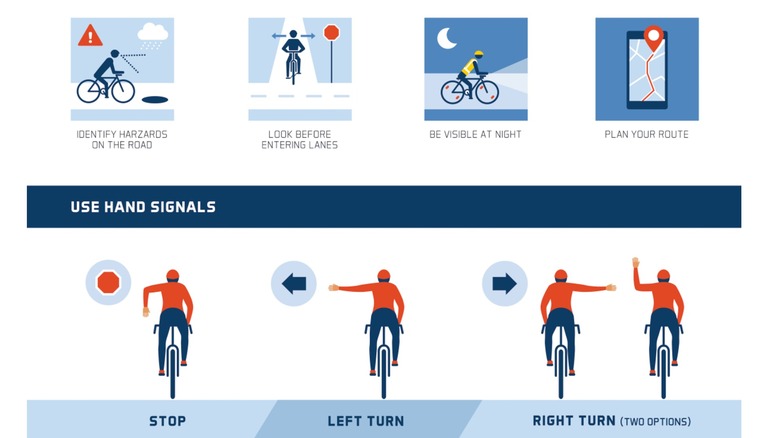
One of the most important things to be while out on the road is predictable. That's precisely what brake lights and turn signals are there for: so that you can be predictable to oncoming traffic and the motorists behind you. They'll know when you're stopping, when you're changing lanes, or which direction you would like to go. Unfortunately, one of the most popular vehicle types on the road today, the bicycle, usually has none of these lights. The core design of a bicycle is to be sturdy, efficient,
versatile, and simple to ride, so that's probably why many manufacturers don't add electric turn signals to them.
However, bicyclists (and motorcyclists who are having issues with their turn signals) must still indicate where they're going while riding on the road. Therefore, states have laws guiding what kind of gestures you can make when turn signals or lights aren't available to you-- biker or not. Many states agree that pointing your left or right arm out in the respective direction you wish to go is a good way to indicate your direction. That means pointing your right arm out horizontally is how to indicate you're going right, and vice versa for the left. But the NHTSA and some states, like New York, provide that you can also use your left hand in an L-shaped gesture when turning right and history suggests that this stems from the time cars didn't have turn signals.
Read more: Every Motorcycle Keanu Reeves Owns In His Stunning Collection
Where Does This Signal Style Come From?

The current NHTSA guideline says you can stick out your left hand and hold your forearm up in a 90-degree L-shape to indicate a right turn. It's now become one of the common motorcycle signals you should know. You may be wondering why this is so; after all, pointing in the direction of where you're going is more intuitive. While you can also do that, you have to ask yourself how it was possible that cars could indicate where they were going before turn signals -- or indicators if you're British -- were invented.
Before electronic turn signals became standard in the mid-20th century, drivers had to use hand gestures through their driver-side window to communicate their intentions. But since a car's steering wheel is on the left side in the U.S., the driver could only reasonably use their left arm to signal. This led to a set of universal left-hand signals for all directions, including right turns.
So instead of reaching across the cabin to awkwardly stick out their right hand, drivers would simply bend their left arm at a 90-degree angle to indicate a right turn. It became a standard gesture that eventually got codified into traffic law and has remained in the century-old Uniform Vehicle Code (UVC). Even though bicycles aren't cars, they inherited this signaling language. Thanks to this consistency of gestures, everyone on the road, regardless of vehicle, would speak the same visual language. It's also a great way to maintain control for right-handed bikers, since they can use their dominant hand to steer while signaling intended directions to traffic.
Want the latest in tech and auto trends? Subscribe to our free newsletter for the latest headlines, expert guides, and how-to tips, one email at a time.
Read the original article on SlashGear.












